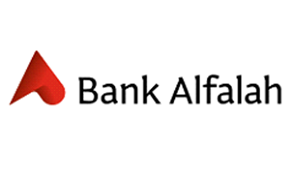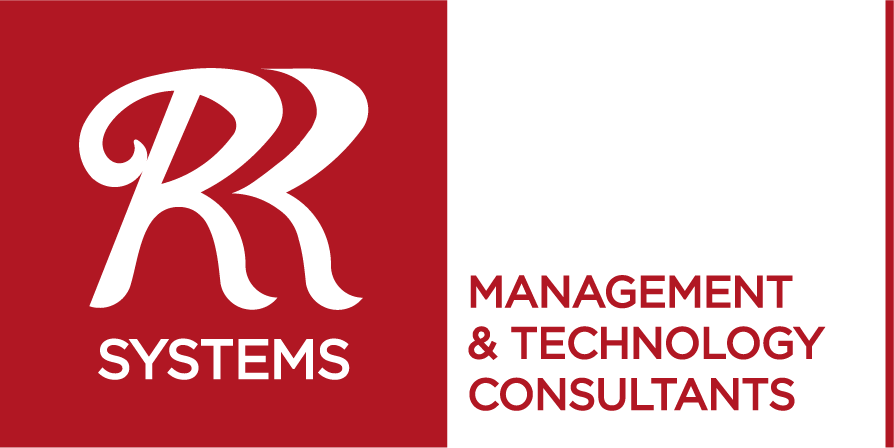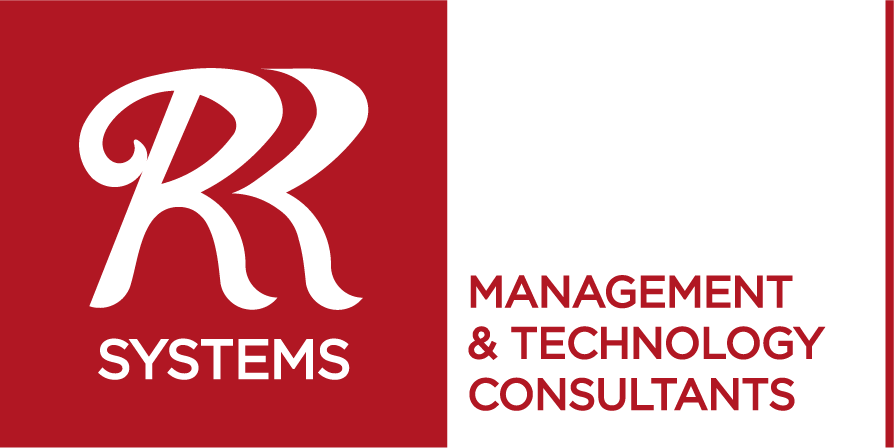Evolving the Internal Audit Function
eAudit
Streamline Compliance, Enhance Transparency, and Empower Your Team with eAudit. Your All-in-One Solution for Efficient, Effective, and Insightful Internal Audits.

Make Audits Easier Than Ever!
Streamline the audit process to reduce audit costs and time spent. Designed to increase efficiency and productivity at all stages of the audit process.

Dashboards & Reporting
Get visibility over the entire audit function within your organization with a robust MIS reporting module and a powerful dashboard utility to provide a bird’s-eye view of key audit statistics to aid in the ongoing audit process and provide insights for future audit management.

Plan, Schedule, and Manage Audits
Enable management to plan, schedule, and manage assignments by generating Audit plans based on detailed risk assessments using a variety of risk factors to ensure an effective audit.

Work Smart with eAudit
Utilize the latest in internal audit best practices along with features designed closely with experts in the internal audit field to enable standardization and efficiency to help support and evolve the internal audit function.

Secure and Configurable Role Based Access
Incorporating a secure and completely configurable role based access system. With a built-in list of over 400 permissions, users can be assigned multiple specifically configured roles to control access to modules, screens, data and functionality across the solution

Seamless Integration
Easily integrate eAudit with external systems and data warehouses to enable the seamless fetching of data such as entity performance data, qualitative values to inform risk assessments, and population data for automated sampling.
eAudit Modules & Features
- Administration
- Risk Management
- Planning
- Audit Execution
- Reporting & Compliance
- Stakeholder & Collaboration Tools
- Data Reporting & Libraries
Application Parameters
The Application Parameter module is designed to be highly configurable, offering users extensive control over interface settings and functional parameters to tailor the solution to organizational needs. Key customization options include:
- Application and Reporting Parameters: Configure core settings for optimal performance and reporting output.
- Active Directory and LDAP Settings: Integrate with directory services for secure, centralized access control.
- Audit Report Formats: Customize report templates to align with organizational standards.
- On-Screen Labels, Messages, and Lists of Values: Modify text labels, notifications, and dropdown lists to match internal terminology.
- Reminder Schedules and Escalation Workflows: Set up automated reminders and escalation paths to keep tasks on track.
- Task and Approval Workflows: Define workflows for task assignments and approvals to streamline audit processes.
- Holiday Calendar: Input relevant holidays to ensure accurate scheduling and resource planning.
- Country Setup: Configure country-specific settings to meet regional requirements.

User Management & Access Control
- eAudit offers robust User Management & Access Control capabilities, enabling precise and secure role-based access for each user. With over 400 built-in permissions across modules and functions, administrators can assign and customize roles to meet organizational security requirements. Key features include:
- Comprehensive Role-Based Access: Assign users multiple roles, with specific permissions for menu access, and the ability to view, create, edit, or delete records.
- Review & Approval Authority: Define who can review and approve actions within the system, ensuring compliance and accountability.
- Departmental Access Restriction: Allocate users to specific departments, allowing them to view engagement data only within their designated area for added confidentiality and control.
- This module provides the flexibility to fine-tune user permissions, ensuring that each user has access appropriate to their role and responsibilities.
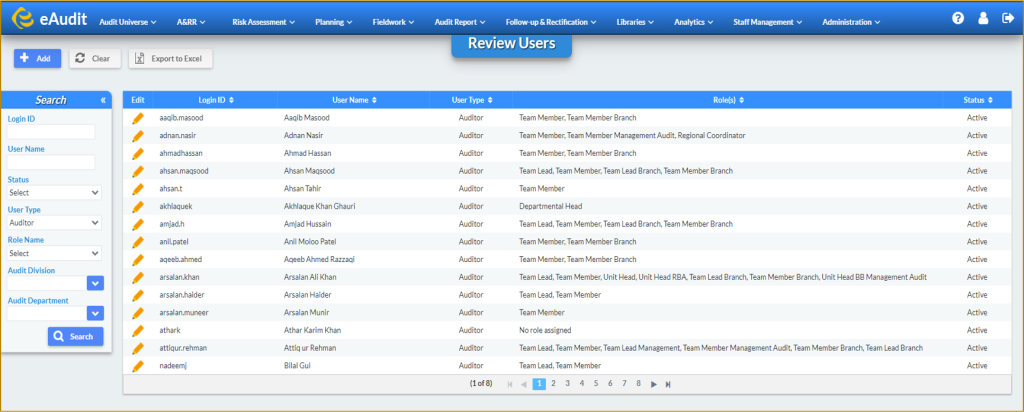
Workflow Management
eAudit’s Approval Workflow Management feature provides fully configurable, multi-level review and approval processes across the system. Tailored workflows can be established for each department and module, ensuring that every action undergoes the appropriate level of oversight. This feature supports custom approvals based on role, hierarchy, or department requirements, promoting efficiency and accountability throughout the audit lifecycle.
With flexible workflow settings, eAudit adapts seamlessly to organizational approval structures, enhancing control and transparency in decision-making processes.
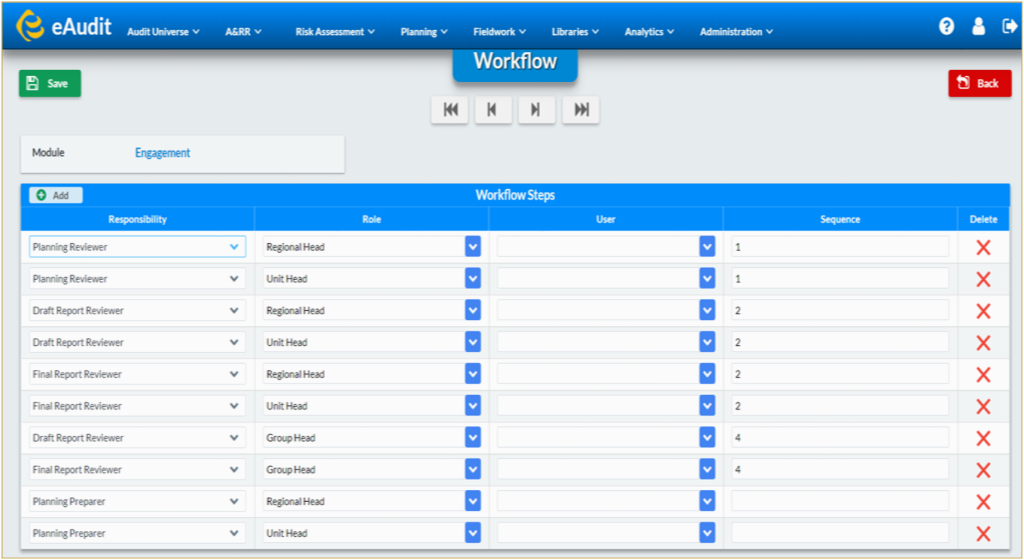
External System Integration
eAudit’s External System Integration module enables smooth connectivity with external systems, such as data warehouses, to enrich audit processes with relevant data. This integration allows for the automatic retrieval of key information, including:
- Entity Performance Data: Access essential metrics to assess and monitor entity performance.
- Quantitative Values for Risk Assessment: Import data such as transaction counts, deposit totals, and other quantitative indicators critical for accurate risk analysis.
- Automated Population and Sampling: Leverage integrated data for streamlined, automated sampling and population selection in audit procedures.
This module enhances the audit process by providing real-time access to critical data sources, supporting a more data-driven, efficient audit workflow.

Risk Register
eAudit’s centralized Risk Register provides a structured approach to defining and managing the risks associated with each audit engagement. Tailored for each audit department, it enables the creation of detailed lists of processes, risks, and controls that can be linked directly to audit tests, supporting RCM-based (Risk Control Matrix) audits. Key setup features include:
- Process and Control Owners: Assign accountable owners to ensure clear responsibility for each risk and control.
- Risk Impact and Rating: Define and rate the impact of each risk to prioritize resources effectively.
- Control Categories and Frequency: Classify controls by type and set their testing frequency for comprehensive coverage.
The Risk Register module helps establish a consistent, in-depth framework for risk assessment, aligning audit scope with identified risks and controls for greater oversight and efficiency.
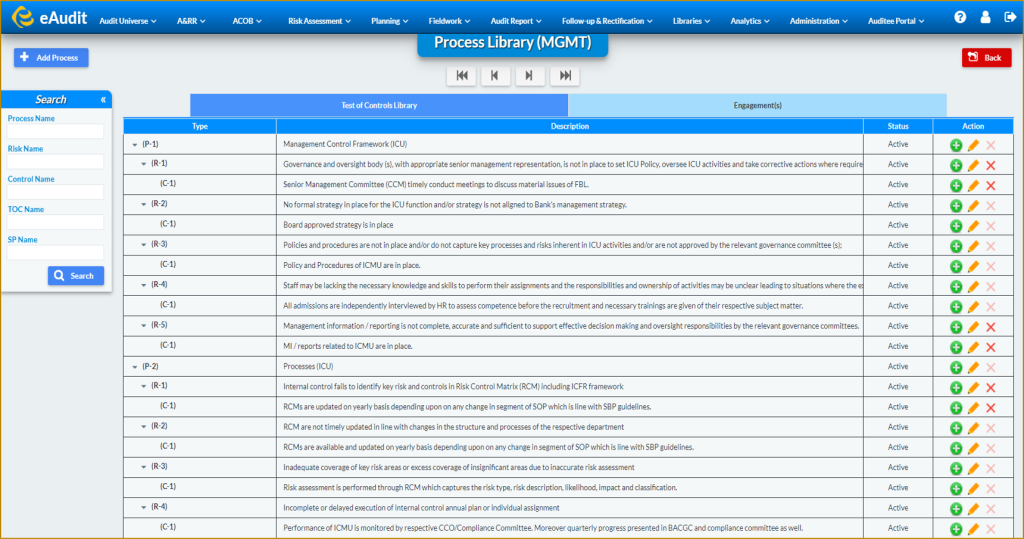
Risk Assessment
The Risk Assessment module in eAudit allows for comprehensive, multi-level risk evaluations, tailored with user-defined factors, sub-factors, and weightages to meet specific organizational needs. This intelligent assessment tool utilizes various data sources for a balanced view of risk, including:
- Quantitative Data from Previous Audits: Leverage historical audit data for more accurate risk predictions.
- Quantitative Data from External Systems: Integrate external performance metrics to enhance risk insights.
- Inherent Risk Ratings from the Risk Register: Utilize predefined risk ratings for targeted risk assessment.
- Qualitative Values Using Subjective Factors: Incorporate subjective factors to address nuanced risk considerations.
With these capabilities, the Risk Assessment module supports a data-driven approach, enabling more informed and reliable risk evaluations across the organization.
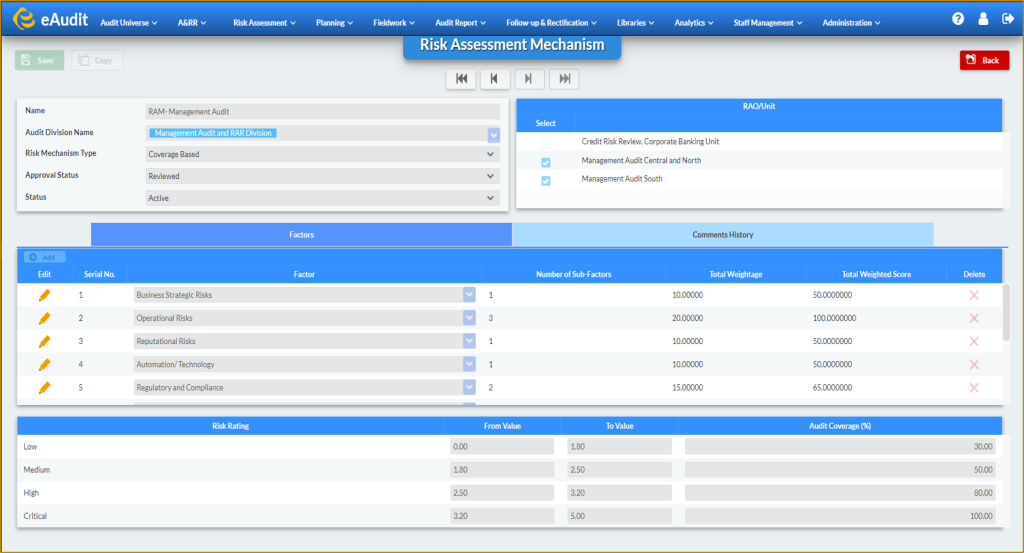
Annual & Periodic Planning
eAudit’s Annual & Periodic Planning module enables effective audit scheduling and resource allocation for the entire audit year, leveraging risk assessment data to focus on high-risk areas. Key planning functions include:
- Prioritization of High-Risk Areas: Utilize risk data to ensure audits target the most critical areas.
- Comprehensive Engagement Planning: Select entities, set tentative timelines, assign audit teams, and establish time and expense budgets for each engagement.
- The Periodic Planning feature allows for adjustments to the approved annual plan as priorities shift, while eAudit’s Unplanned Assignment module facilitates ad-hoc audits for emerging needs at any time during the year.
This module provides the flexibility to adapt plans throughout the year, ensuring that audit resources are aligned with organizational priorities and risks.
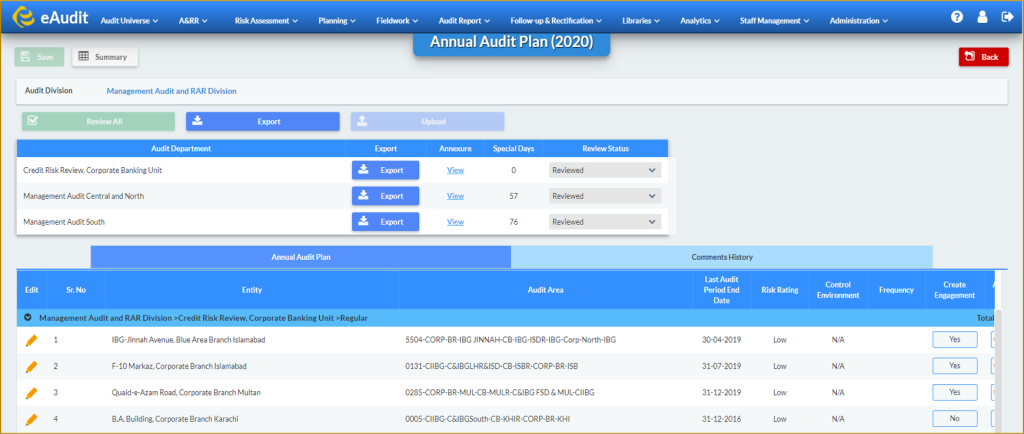
Engagement Planning
The Engagement Planning module in eAudit facilitates structured pre-engagement activities, ensuring each audit aligns with organizational objectives from the outset. This feature provides a comprehensive framework for setting up and executing audits with efficiency and precision. Key components include:
- Defining Engagement Scope and Objectives: Clearly outline the engagement’s purpose, objectives, auditees, and audit teams.
- Establishing Timelines and Approval Workflows: Set timelines and configure engagement-specific workflows to streamline approvals.
- Linking to Audit Programs and Risk Register: Integrate relevant pre-defined audit programs and risks from the Risk Register for comprehensive coverage.
- Generating Engagement Documents: Create and share engagement letters and plans with designated action owners.
Additional tools include engagement-level risk assessments to refine risk ratings, population file collection for sampling, and assignment of working papers to team members for audit fieldwork.
This module ensures that each engagement is meticulously planned, enabling auditors to proceed confidently and in alignment with strategic audit goals.
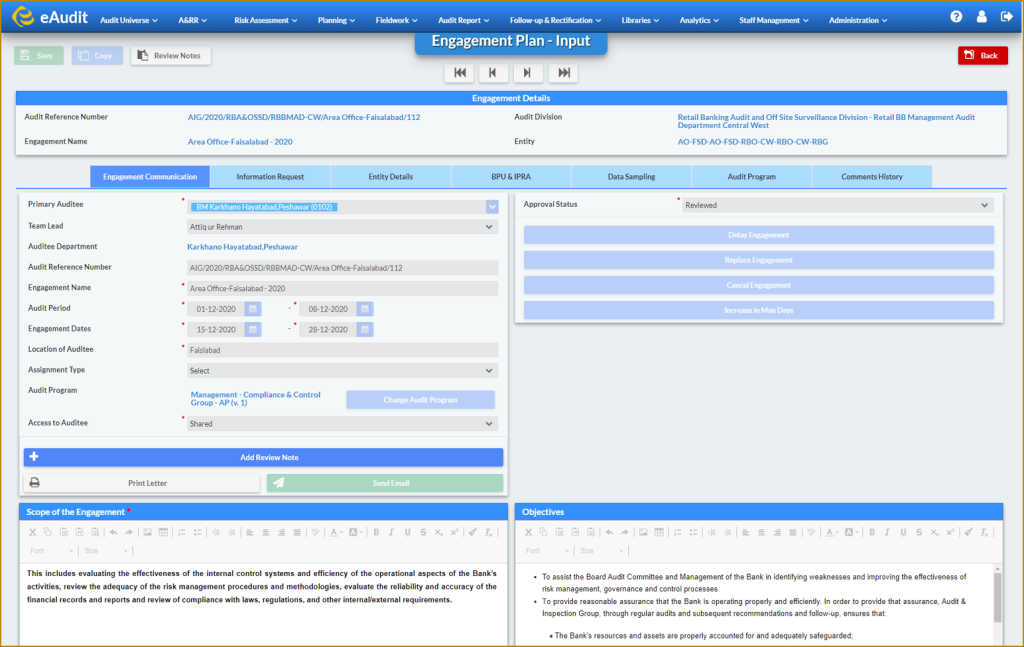
Information Requests
The Information Requests module in eAudit streamlines the process of requesting and managing documents and data during audits. Key features include:
- Request Sharing: Easily send information requests to auditors and auditees for each engagement.
- Scheduling and Follow-up: Set deadlines for request fulfillment and automate reminders and escalations to ensure timely responses.
- Document Collection: Receive documents and attachments through a user-friendly portal interface, simplifying the upload and tracking process.
This module improves communication and ensures efficient management of required information, helping keep audits on track and within scope.
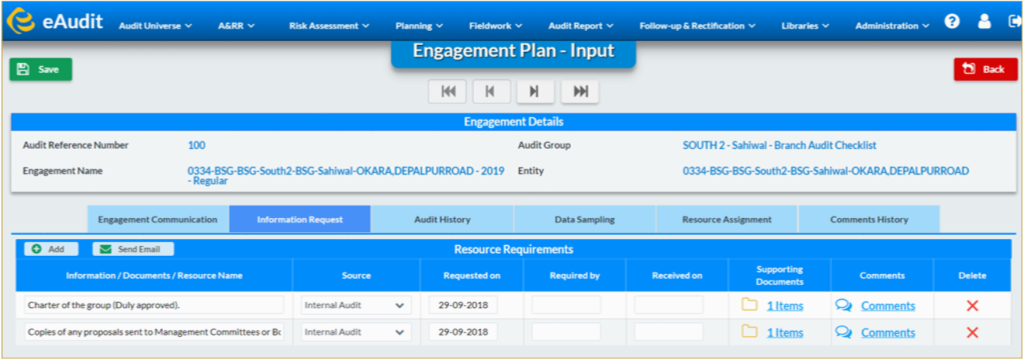
Population & Sample Data
The Population & Sample Generation feature in eAudit automates the selection of audit samples, streamlining the process and enhancing audit accuracy. Key features include:
- Automated Population Gathering: Collect relevant data from defined populations to ensure comprehensive coverage.
- Pre-defined Sampling Methodologies: Use a variety of pre-configured sampling methodologies, such as random, stratified, and judgmental sampling, either individually or in combination, to generate meaningful and representative samples.
This module improves the efficiency and consistency of sample generation, ensuring that the samples are both statistically relevant and aligned with audit objectives.
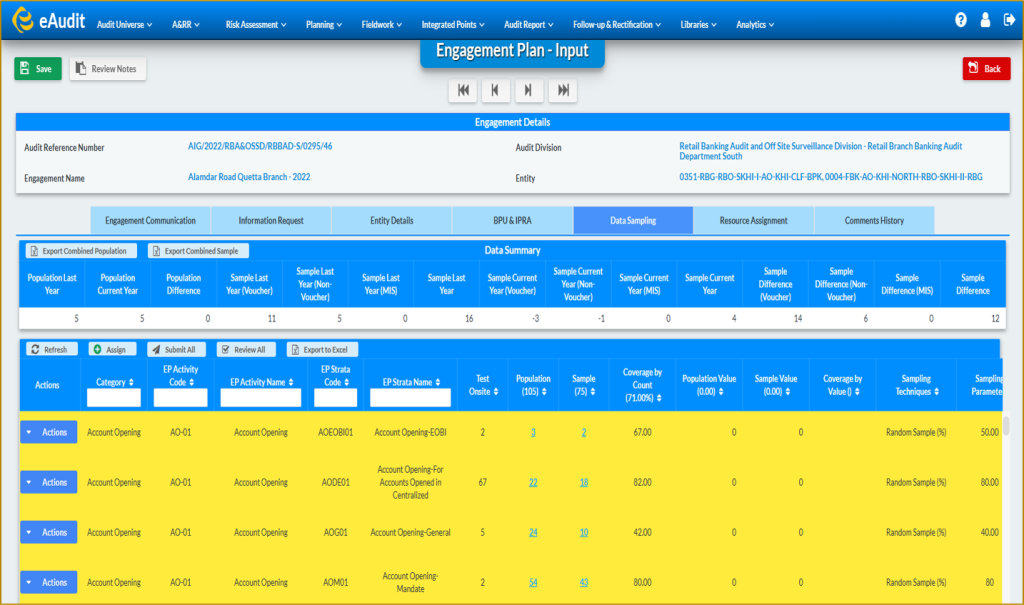
Electronic Working Papers
The Electronic Working Papers module in eAudit provides a centralized platform for collaboration, documentation, and progress tracking during audit fieldwork. Key features include:
- Collaborative Workspace: Enable audit teams to work together in real-time, documenting findings, observations, and updates directly within the working papers.
- Descriptive Audit Capability: Conduct descriptive audits by manually drafting findings and observations.
- Linking Processes, Risks, and Controls: Systematically link relevant processes, risks, and controls to the working papers for a more structured and comprehensive audit approach.
This module enhances the efficiency of the audit execution phase, ensuring all documentation is well-organized and easily accessible while fostering collaboration across audit teams.
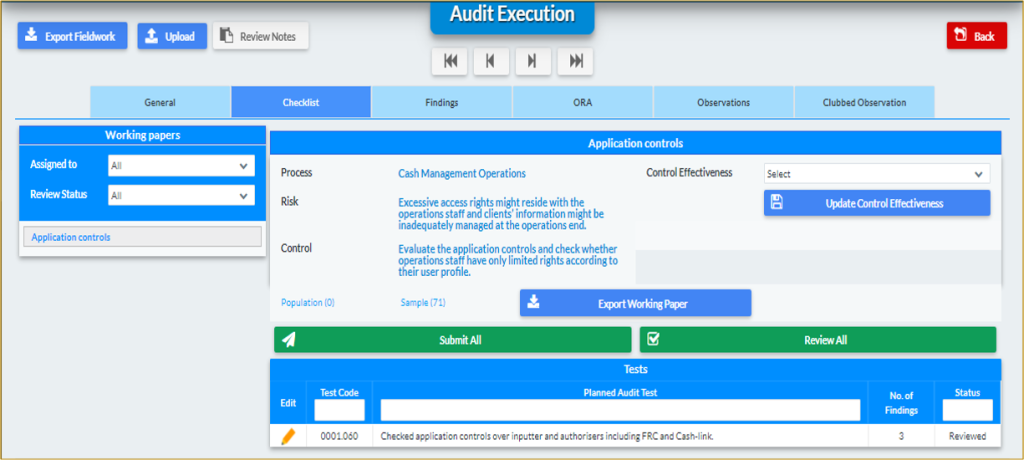
Instance-Wise Audits
The Instance-Wise Audits module in eAudit is designed for checklist-based fieldwork, specifically tailored for conducting branch audits. Key features include:
- Checklist-Based Fieldwork: Mark instances from the assigned sample against pre-defined exceptions to ensure thorough audit coverage.
- Linking with Process Library: Integrate the process library for a more detailed and systematic audit approach, providing greater context and control over the audit process.
This module enhances audit accuracy by allowing auditors to focus on specific instances and exceptions, ensuring a comprehensive review of each branch or unit being audited.
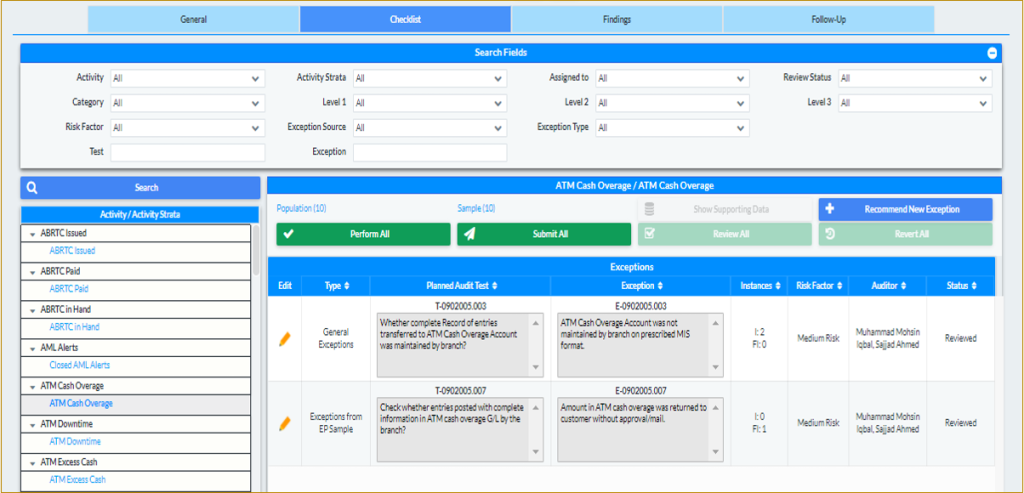
Party-Wise Audits
The Party-Wise Audits module in eAudit is designed for item-based fieldwork, specifically suited for portfolio audits. Key features include:
- Party-Wise Checklist Execution: Conduct audits by executing checklists item by item, focusing on individual parties or units within the portfolio.
- Detailed Borrower Card: Capture critical borrower information through a comprehensive borrower card interface, enabling detailed tracking and analysis of borrower-specific data.
- Linking with Process Library: Integrate the process library for a more detailed and structured audit approach, ensuring consistency and thoroughness in audit execution.
This module allows for focused and efficient audits of portfolios, enabling a more systematic and detailed review of each party or item in the audit scope.
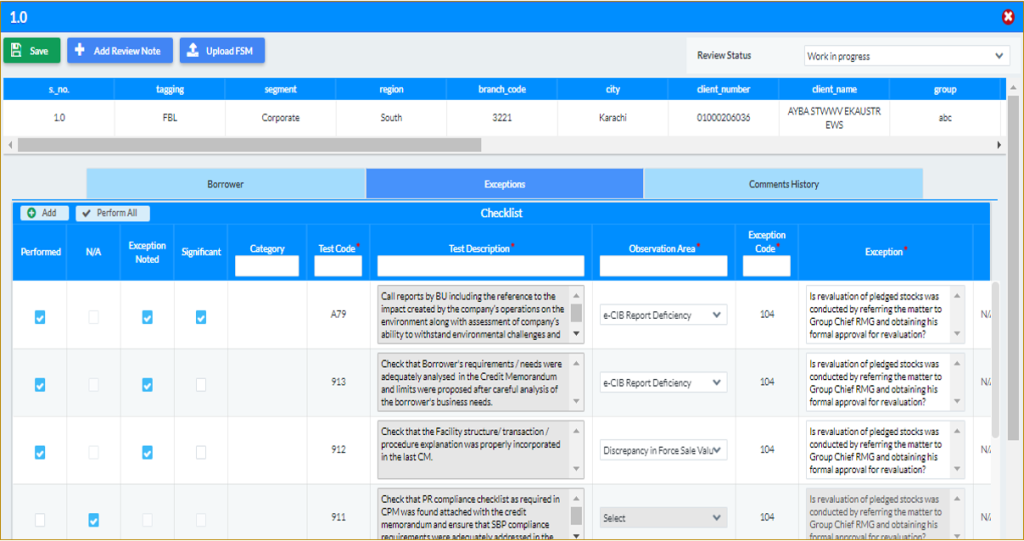
Continuous Audit
eAudit’s Continuous Audit module enables real-time monitoring to proactively identify discrepancies and provide immediate insights into operational performance. Unlike traditional periodic audits, this module offers ongoing assurance of the accuracy and reliability of internal controls. Key benefits include:
- Operational Efficiency: Enhance the efficiency and effectiveness of business operations by continuously monitoring critical processes.
- Regulatory Compliance: Improve compliance with regulatory requirements through constant oversight and automated reporting.
- Risk and Opportunity Insights: Gain a deeper understanding of organizational risks and opportunities, enabling better decision-making and strategic planning.
This module helps organizations stay ahead of potential issues by providing continuous oversight, ensuring internal controls remain robust and operations stay aligned with business goals.
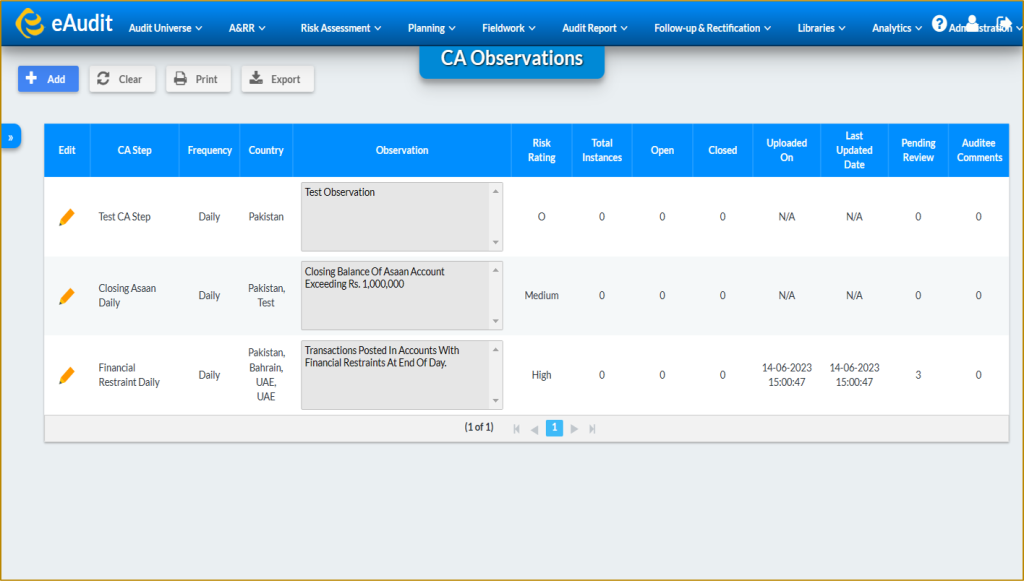
Special Assignments
eAudit’s Special Assignments and Thematic Reviews module enables a focused, systematic approach to internal auditing across multiple entities, processes, regions, or the entire organization. Key features include:
- Thematic Audits: Perform audits based on specific themes, addressing key processes, risks, or strategic initiatives, beyond the scope of traditional financial and compliance audits.
- Cross-Entity Auditing: Execute thematic audits across multiple audit entities or regions, providing a comprehensive view of organization-wide risks and opportunities.
- Customized Reporting: Utilize tailored thematic audit report formats to ensure alignment with internal audit processes and compliance requirements.
This module empowers auditors to address complex organizational challenges and strategic areas, ensuring that audits are both relevant and aligned with the company’s broader objectives.
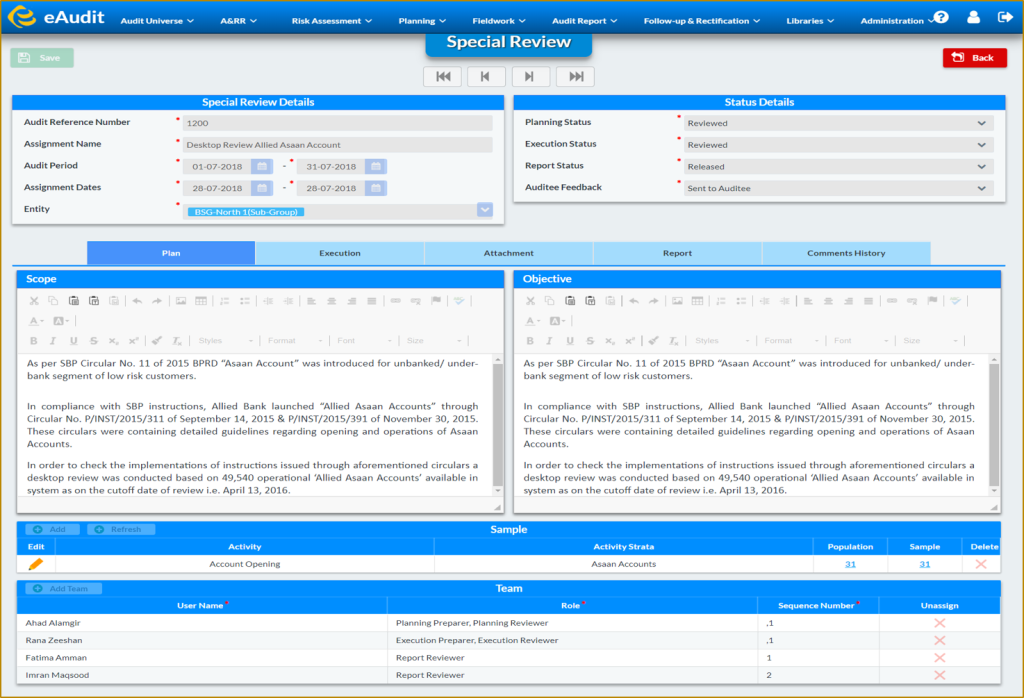
Investigations
eAudit’s Investigations module provides a structured approach for recording and tracking incidents of fraud, forgery, and other irregularities within the organization. Key features include:
- Preliminary Fraud Reports: Capture and document preliminary reports of fraud and forgery submitted by field teams, ensuring immediate attention.
- Whistleblowing Tracking: Record and manage instances of whistleblowing, ensuring confidentiality and proper follow-up.
- Loss Tracking: Monitor and track financial losses due to fraud, income leakage, or other irregularities.
- Specialized Investigation Interface: Conduct thorough investigations using a dedicated interface, enabling detailed and separate tracking of relevant data points for accurate and efficient analysis.
This module enables organizations to maintain control over sensitive investigations, ensuring they are documented, tracked, and resolved with due diligence.

Draft & Final Reporting
eAudit’s Draft & Final Reporting module streamlines the generation of audit reports, enhancing both standardization and efficiency. Key features include:
- Customized Report Formats: Generate audit reports using tailored, customizable formats to maintain consistency and meet specific organizational needs.
- Time Efficiency: Significantly reduce the time spent drafting reports by automating key processes and enabling real-time updates.
- Content Flexibility: Easily add a variety of content types, including text, images, tables, and new sections, with instant preview of changes.
- Auditee Feedback Integration: Receive feedback from auditees through the included portal, track resolution timelines for observations, and automatically incorporate this information into the final reports.
This module ensures that audit reports are not only standardized but also delivered efficiently, with seamless integration of auditee responses for comprehensive and timely reporting.
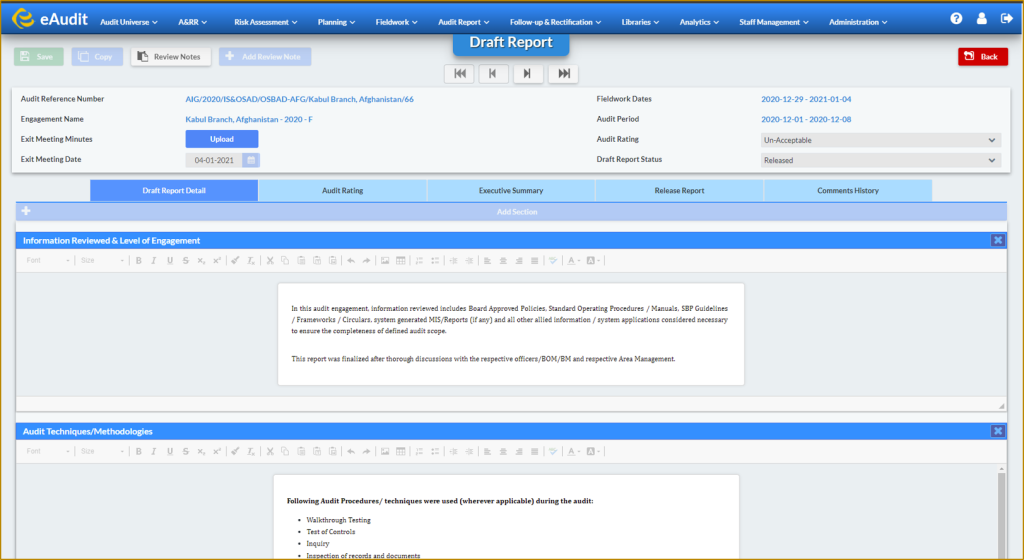
Compliance & Follow-up
eAudit’s Compliance & Follow-up module ensures that all audit findings, observations, and recommendations are properly tracked and resolved. Key features include:
- Centralized Tracking: Monitor and manage all findings, observations, instances, and audit recommendations in one centralized system.
- Auditee Access and Feedback: Provide auditees with access to view assigned follow-up items and submit feedback, enabling transparent communication and accountability.
- Resolution Tracking: Track the status of each item’s resolution in real-time through user dashboards and MIS Reports.
- Automated Escalation: Set up reminder schedules and automated email escalations for unresolved items, ensuring timely follow-up and closure.
This module enhances the efficiency and accountability of the follow-up process, ensuring that audit findings are addressed promptly and in compliance with organizational and regulatory standards.
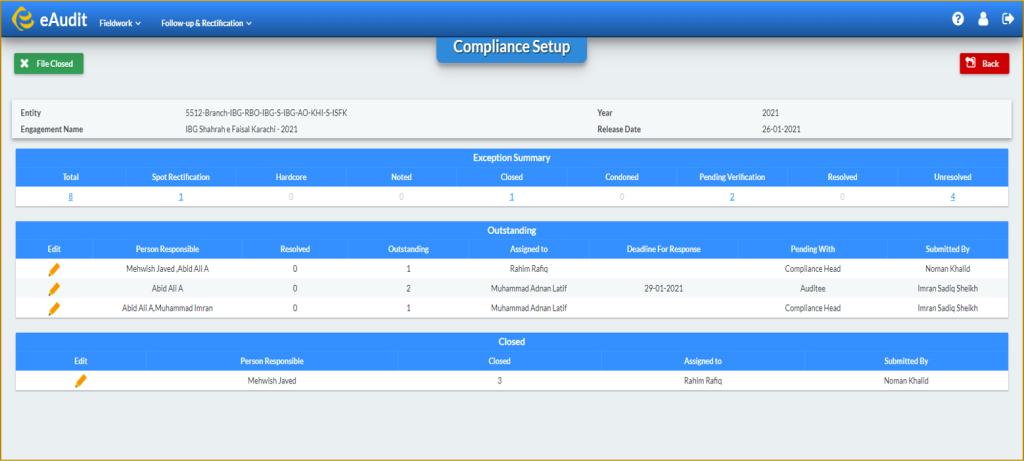
Quality Assurance
eAudit’s Quality Assurance module ensures the integrity and effectiveness of the audit process, both during and after the engagement. Key features include:
- Ongoing Quality Assurance: Conduct real-time reviews throughout the audit process using customizable quality assurance checklists. This feature can be configured to be mandatory for high-risk engagements, ensuring consistent quality throughout the audit.
- Post-Engagement Review: After the final report is released, conduct a comprehensive review of the entire audit cycle, ensuring all steps and outcomes meet the highest standards.
- Resolution Tracking: Track the resolution of quality assurance issues identified during both the ongoing and post-engagement reviews, ensuring all concerns are addressed promptly.
This module enhances audit quality by embedding continuous oversight and post-engagement reviews, helping to maintain the reliability and thoroughness of audits.
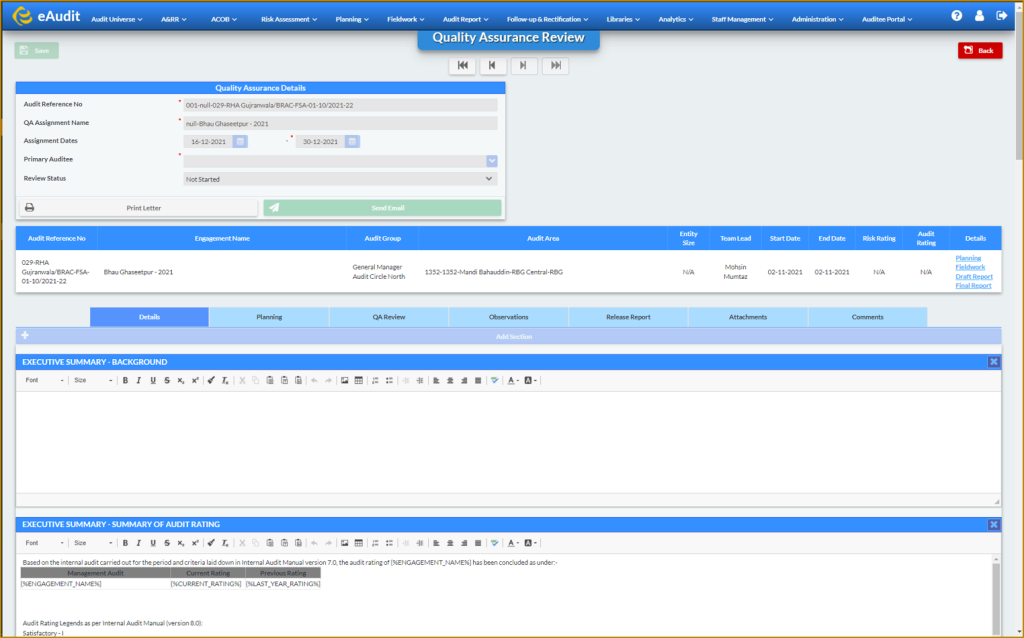
Auditee Portal
The Auditee Portal in eAudit facilitates seamless collaboration between auditors and auditees, providing a platform for efficient communication and document management. Key features include:
- Document Submission: Allow auditees to easily submit responses, documents, and evidence directly through the portal.
- Real-Time Collaboration: Foster collaboration by enabling auditees to engage with auditors, providing feedback and updates on assigned follow-up items.
- Efficient Communication: Streamline communication between auditors and auditees, ensuring timely exchange of information and tracking of audit progress.
This module empowers auditees to actively participate in the audit process, enhancing transparency and improving overall audit efficiency.
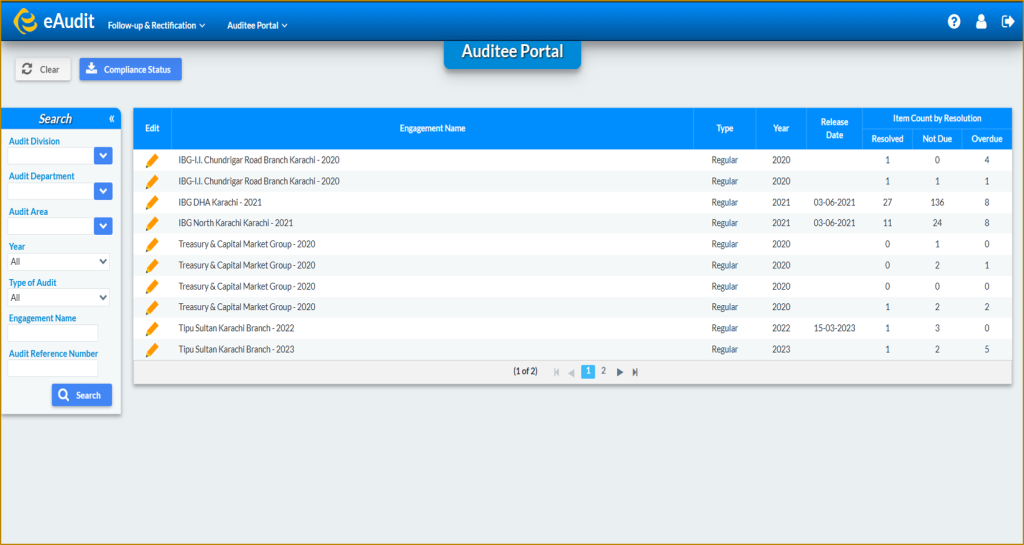
ACOB Meetings
eAudit’s Auditee Committee Board Meetings (ACOB) module streamlines the scheduling, management, and tracking of Audit Committee meetings. Key features include:
- Meeting Scheduling: Easily schedule Audit Committee meetings, ensuring all stakeholders are notified in advance.
- Agenda Definition: Define and distribute detailed meeting agendas to ensure structured and focused discussions.
- Minutes Recording: Capture meeting minutes directly in the system, ensuring accurate documentation of discussions and decisions.
- Actionable Items: Define actionable items with due dates, assign responsibilities, and track the completion of tasks to ensure follow-through.
This module helps manage the entire meeting lifecycle, ensuring that key decisions are documented, action items are tracked, and the Audit Committee can operate efficiently and with full transparency.
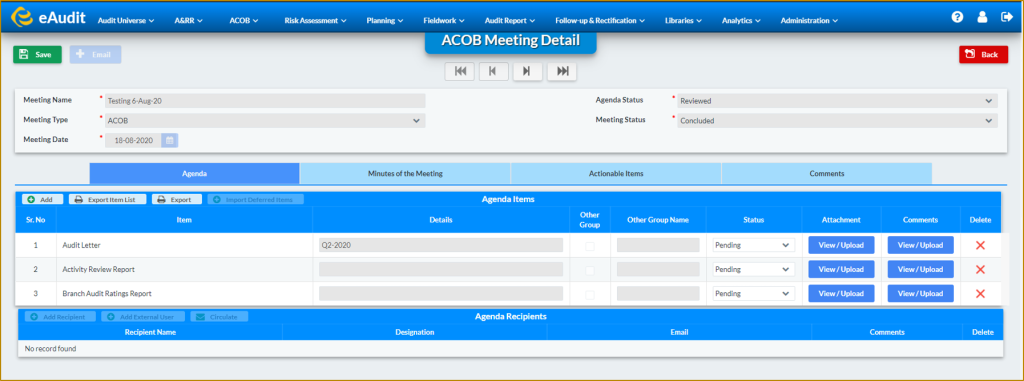
Third-Party Audits
eAudit’s Third-Party Audits module allows you to seamlessly import and track third-party audit results within the system. Key features include:
- Import Third-Party Audit Results: Easily import audit reports and findings from external parties into the system for centralized management.
- Integration with Compliance & Follow-up: Automatically link third-party audit findings with the Compliance & Follow-up module for tracking resolutions, feedback, and actions.
- Centralized Tracking: Monitor the progress of third-party audit resolutions alongside internal audit findings, ensuring consistent oversight and follow-up.
- Efficient Collaboration: Facilitate communication between internal audit teams and third-party auditors for timely updates and resolution tracking.
This module ensures that third-party audits are effectively integrated into the overall audit management process, improving transparency and accountability across all audit activities.
Auditee Satisfaction Surveys
eAudit’s Auditee Satisfaction Surveys module enables organizations to gather valuable feedback from auditees on the audit process. Key features include:
- Customizable Surveys: Create and distribute tailored satisfaction surveys to auditees, allowing for feedback on various aspects of the audit process.
- Automated Distribution: Automatically send surveys to auditees upon the completion of each engagement or audit phase.
- Feedback Collection: Collect and analyze responses to gain insights into the auditee experience, including areas of improvement and strengths.
- Reporting & Analytics: Generate reports and actionable insights from survey data to enhance future audits and improve auditor-auditee relationships.
This module helps improve audit quality and enhances stakeholder relationships by ensuring that auditee feedback is captured, analyzed, and acted upon to drive continuous improvement.
Dashboards
eAudit’s Dashboards module provides management with real-time, in-depth insights into the status and progress of audits. Key features include:
- Comprehensive Overview: View a bird’s-eye view of engagement statuses, resolution progress, budget tracking, and more, all in one place.
- Categorization of Exceptions: Monitor the categorization and tracking of exceptions to understand key audit issues and areas requiring attention.
- Customizable Visuals: Tailor dashboards to display key performance indicators (KPIs), metrics, and data visualizations that align with organizational priorities.
- Real-Time Data: Access up-to-date data on audit activities, helping management make informed decisions and take timely actions.
This module helps management stay informed, track audit performance, and make data-driven decisions to ensure the success of audit engagements.
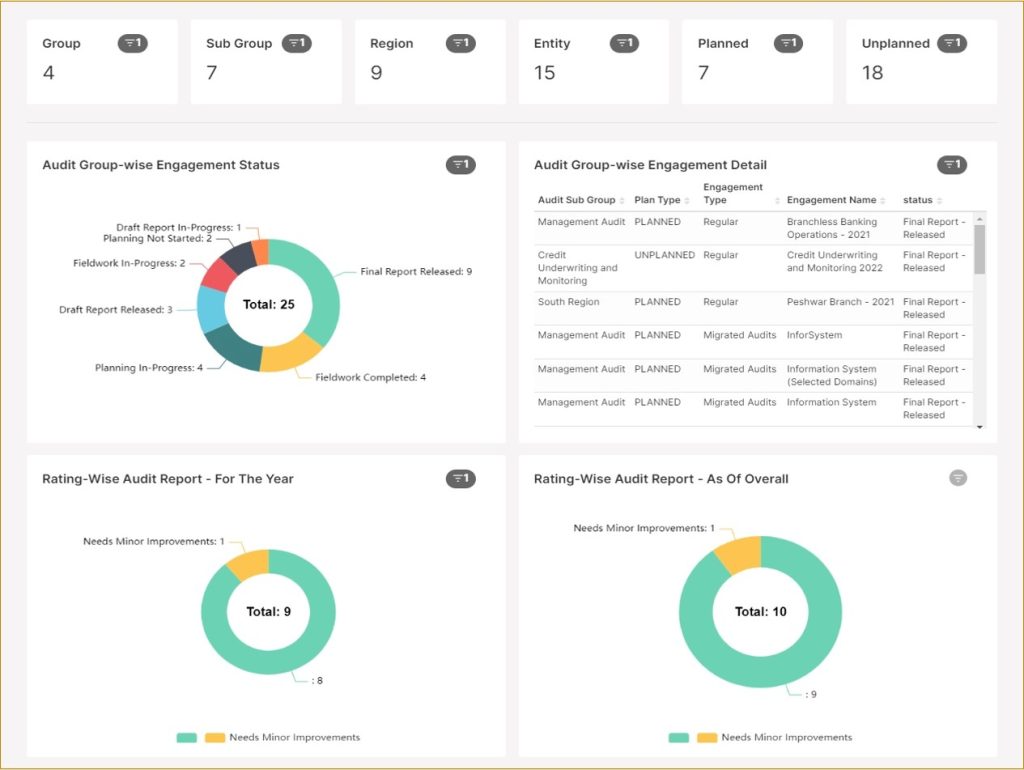
MIS Reports
eAudit’s MIS Reports module provides a comprehensive suite of pre-built and customizable reports to track key audit metrics and performance. Key features include:
- Comprehensive Reporting: Access a variety of meaningful reports covering all aspects of the audit process, from risk assessments to follow-up status.
- Customizable Reports: Develop customized reports tailored to specific needs, using existing report formats or creating new ones.
- Integrated Reporting Server: Utilize an integrated reporting server tool to design, publish, and distribute new reports, ensuring flexibility and scalability.
- Real-Time Insights: Generate real-time reports that provide valuable insights into audit performance, risk management, and compliance status.
This module enhances reporting capabilities, allowing organizations to create and access dynamic, actionable reports that support decision-making and continuous improvement in the audit process.
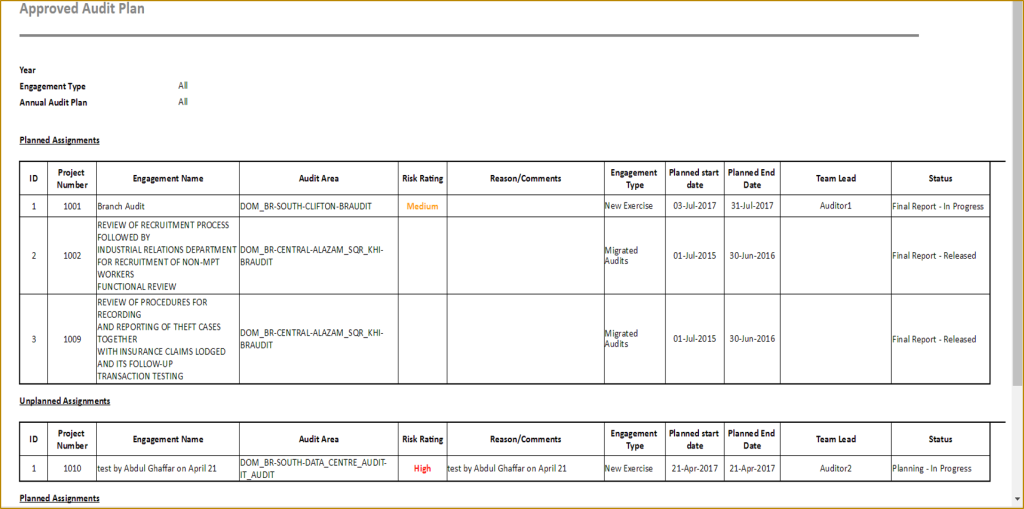
Application Parameters
The Application Parameter module is designed to be highly configurable, offering users extensive control over interface settings and functional parameters to tailor the solution to organizational needs. Key customization options include:
- Application and Reporting Parameters: Configure core settings for optimal performance and reporting output.
- Active Directory and LDAP Settings: Integrate with directory services for secure, centralized access control.
- Audit Report Formats: Customize report templates to align with organizational standards.
- On-Screen Labels, Messages, and Lists of Values: Modify text labels, notifications, and dropdown lists to match internal terminology.
- Reminder Schedules and Escalation Workflows: Set up automated reminders and escalation paths to keep tasks on track.
- Task and Approval Workflows: Define workflows for task assignments and approvals to streamline audit processes.
- Holiday Calendar: Input relevant holidays to ensure accurate scheduling and resource planning.
- Country Setup: Configure country-specific settings to meet regional requirements.

User Management & Access Control
- eAudit offers robust User Management & Access Control capabilities, enabling precise and secure role-based access for each user. With over 400 built-in permissions across modules and functions, administrators can assign and customize roles to meet organizational security requirements. Key features include:
- Comprehensive Role-Based Access: Assign users multiple roles, with specific permissions for menu access, and the ability to view, create, edit, or delete records.
- Review & Approval Authority: Define who can review and approve actions within the system, ensuring compliance and accountability.
- Departmental Access Restriction: Allocate users to specific departments, allowing them to view engagement data only within their designated area for added confidentiality and control.
- This module provides the flexibility to fine-tune user permissions, ensuring that each user has access appropriate to their role and responsibilities.

Workflow Management
eAudit’s Approval Workflow Management feature provides fully configurable, multi-level review and approval processes across the system. Tailored workflows can be established for each department and module, ensuring that every action undergoes the appropriate level of oversight. This feature supports custom approvals based on role, hierarchy, or department requirements, promoting efficiency and accountability throughout the audit lifecycle.
With flexible workflow settings, eAudit adapts seamlessly to organizational approval structures, enhancing control and transparency in decision-making processes.

External System Integration
eAudit’s External System Integration module enables smooth connectivity with external systems, such as data warehouses, to enrich audit processes with relevant data. This integration allows for the automatic retrieval of key information, including:
- Entity Performance Data: Access essential metrics to assess and monitor entity performance.
- Quantitative Values for Risk Assessment: Import data such as transaction counts, deposit totals, and other quantitative indicators critical for accurate risk analysis.
- Automated Population and Sampling: Leverage integrated data for streamlined, automated sampling and population selection in audit procedures.
This module enhances the audit process by providing real-time access to critical data sources, supporting a more data-driven, efficient audit workflow.

Application Parameters
The Application Parameter module is designed to be highly configurable, offering users extensive control over interface settings and functional parameters to tailor the solution to organizational needs. Key customization options include:
- Application and Reporting Parameters: Configure core settings for optimal performance and reporting output.
- Active Directory and LDAP Settings: Integrate with directory services for secure, centralized access control.
- Audit Report Formats: Customize report templates to align with organizational standards.
- On-Screen Labels, Messages, and Lists of Values: Modify text labels, notifications, and dropdown lists to match internal terminology.
- Reminder Schedules and Escalation Workflows: Set up automated reminders and escalation paths to keep tasks on track.
- Task and Approval Workflows: Define workflows for task assignments and approvals to streamline audit processes.
- Holiday Calendar: Input relevant holidays to ensure accurate scheduling and resource planning.
- Country Setup: Configure country-specific settings to meet regional requirements.

User Management & Access Control
- eAudit offers robust User Management & Access Control capabilities, enabling precise and secure role-based access for each user. With over 400 built-in permissions across modules and functions, administrators can assign and customize roles to meet organizational security requirements. Key features include:
- Comprehensive Role-Based Access: Assign users multiple roles, with specific permissions for menu access, and the ability to view, create, edit, or delete records.
- Review & Approval Authority: Define who can review and approve actions within the system, ensuring compliance and accountability.
- Departmental Access Restriction: Allocate users to specific departments, allowing them to view engagement data only within their designated area for added confidentiality and control.
- This module provides the flexibility to fine-tune user permissions, ensuring that each user has access appropriate to their role and responsibilities.

Workflow Management
eAudit’s Approval Workflow Management feature provides fully configurable, multi-level review and approval processes across the system. Tailored workflows can be established for each department and module, ensuring that every action undergoes the appropriate level of oversight. This feature supports custom approvals based on role, hierarchy, or department requirements, promoting efficiency and accountability throughout the audit lifecycle.
With flexible workflow settings, eAudit adapts seamlessly to organizational approval structures, enhancing control and transparency in decision-making processes.

External System Integration
eAudit’s External System Integration module enables smooth connectivity with external systems, such as data warehouses, to enrich audit processes with relevant data. This integration allows for the automatic retrieval of key information, including:
- Entity Performance Data: Access essential metrics to assess and monitor entity performance.
- Quantitative Values for Risk Assessment: Import data such as transaction counts, deposit totals, and other quantitative indicators critical for accurate risk analysis.
- Automated Population and Sampling: Leverage integrated data for streamlined, automated sampling and population selection in audit procedures.
This module enhances the audit process by providing real-time access to critical data sources, supporting a more data-driven, efficient audit workflow.

Application Parameters
The Application Parameter module is designed to be highly configurable, offering users extensive control over interface settings and functional parameters to tailor the solution to organizational needs. Key customization options include:
- Application and Reporting Parameters: Configure core settings for optimal performance and reporting output.
- Active Directory and LDAP Settings: Integrate with directory services for secure, centralized access control.
- Audit Report Formats: Customize report templates to align with organizational standards.
- On-Screen Labels, Messages, and Lists of Values: Modify text labels, notifications, and dropdown lists to match internal terminology.
- Reminder Schedules and Escalation Workflows: Set up automated reminders and escalation paths to keep tasks on track.
- Task and Approval Workflows: Define workflows for task assignments and approvals to streamline audit processes.
- Holiday Calendar: Input relevant holidays to ensure accurate scheduling and resource planning.
- Country Setup: Configure country-specific settings to meet regional requirements.

User Management & Access Control
- eAudit offers robust User Management & Access Control capabilities, enabling precise and secure role-based access for each user. With over 400 built-in permissions across modules and functions, administrators can assign and customize roles to meet organizational security requirements. Key features include:
- Comprehensive Role-Based Access: Assign users multiple roles, with specific permissions for menu access, and the ability to view, create, edit, or delete records.
- Review & Approval Authority: Define who can review and approve actions within the system, ensuring compliance and accountability.
- Departmental Access Restriction: Allocate users to specific departments, allowing them to view engagement data only within their designated area for added confidentiality and control.
- This module provides the flexibility to fine-tune user permissions, ensuring that each user has access appropriate to their role and responsibilities.

Workflow Management
eAudit’s Approval Workflow Management feature provides fully configurable, multi-level review and approval processes across the system. Tailored workflows can be established for each department and module, ensuring that every action undergoes the appropriate level of oversight. This feature supports custom approvals based on role, hierarchy, or department requirements, promoting efficiency and accountability throughout the audit lifecycle.
With flexible workflow settings, eAudit adapts seamlessly to organizational approval structures, enhancing control and transparency in decision-making processes.

External System Integration
eAudit’s External System Integration module enables smooth connectivity with external systems, such as data warehouses, to enrich audit processes with relevant data. This integration allows for the automatic retrieval of key information, including:
- Entity Performance Data: Access essential metrics to assess and monitor entity performance.
- Quantitative Values for Risk Assessment: Import data such as transaction counts, deposit totals, and other quantitative indicators critical for accurate risk analysis.
- Automated Population and Sampling: Leverage integrated data for streamlined, automated sampling and population selection in audit procedures.
This module enhances the audit process by providing real-time access to critical data sources, supporting a more data-driven, efficient audit workflow.

Application Parameters
The Application Parameter module is designed to be highly configurable, offering users extensive control over interface settings and functional parameters to tailor the solution to organizational needs. Key customization options include:
- Application and Reporting Parameters: Configure core settings for optimal performance and reporting output.
- Active Directory and LDAP Settings: Integrate with directory services for secure, centralized access control.
- Audit Report Formats: Customize report templates to align with organizational standards.
- On-Screen Labels, Messages, and Lists of Values: Modify text labels, notifications, and dropdown lists to match internal terminology.
- Reminder Schedules and Escalation Workflows: Set up automated reminders and escalation paths to keep tasks on track.
- Task and Approval Workflows: Define workflows for task assignments and approvals to streamline audit processes.
- Holiday Calendar: Input relevant holidays to ensure accurate scheduling and resource planning.
- Country Setup: Configure country-specific settings to meet regional requirements.

User Management & Access Control
- eAudit offers robust User Management & Access Control capabilities, enabling precise and secure role-based access for each user. With over 400 built-in permissions across modules and functions, administrators can assign and customize roles to meet organizational security requirements. Key features include:
- Comprehensive Role-Based Access: Assign users multiple roles, with specific permissions for menu access, and the ability to view, create, edit, or delete records.
- Review & Approval Authority: Define who can review and approve actions within the system, ensuring compliance and accountability.
- Departmental Access Restriction: Allocate users to specific departments, allowing them to view engagement data only within their designated area for added confidentiality and control.
- This module provides the flexibility to fine-tune user permissions, ensuring that each user has access appropriate to their role and responsibilities.

Workflow Management
eAudit’s Approval Workflow Management feature provides fully configurable, multi-level review and approval processes across the system. Tailored workflows can be established for each department and module, ensuring that every action undergoes the appropriate level of oversight. This feature supports custom approvals based on role, hierarchy, or department requirements, promoting efficiency and accountability throughout the audit lifecycle.
With flexible workflow settings, eAudit adapts seamlessly to organizational approval structures, enhancing control and transparency in decision-making processes.

External System Integration
eAudit’s External System Integration module enables smooth connectivity with external systems, such as data warehouses, to enrich audit processes with relevant data. This integration allows for the automatic retrieval of key information, including:
- Entity Performance Data: Access essential metrics to assess and monitor entity performance.
- Quantitative Values for Risk Assessment: Import data such as transaction counts, deposit totals, and other quantitative indicators critical for accurate risk analysis.
- Automated Population and Sampling: Leverage integrated data for streamlined, automated sampling and population selection in audit procedures.
This module enhances the audit process by providing real-time access to critical data sources, supporting a more data-driven, efficient audit workflow.

Why Choose EAudit

eAudit Solution Lifecycle

our valuable clients
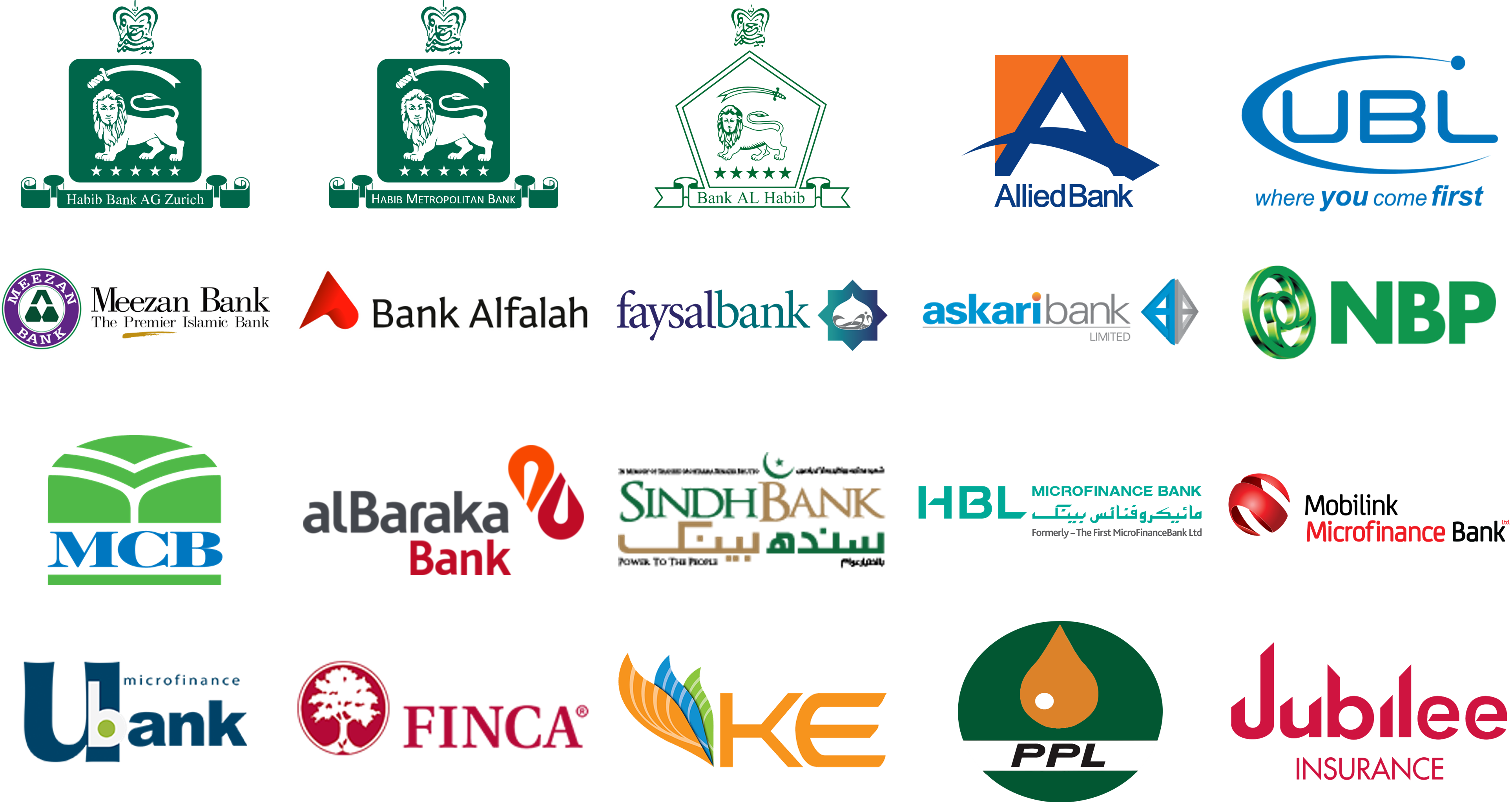
client testimonial
